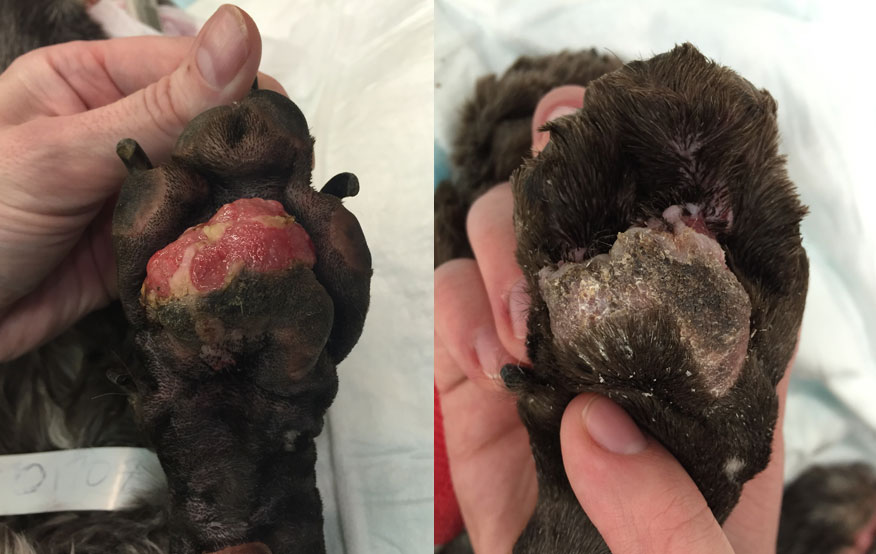Laser Cube Benefits to Referred Patients
Clinical Connections – Spring 2016
RVC Small Animal Referrals has a new laser that can be used to treat a wide variety of conditions and hasten healing for our patients. The K-Laser Cube, a Class IV therapeutic laser, enables RVC clinicians to treat conditions that could otherwise not be treated or would take longer to show improvement.
Class IV therapeutic lasers offer multiple benefits in the treatment of muscle, tendon and ligament injuries, skin wounds, oedema, arthritis, neurological conditions, acute and chronic pain. The laser supports the work of the RVC soft tissue surgery, orthopaedics, neurology, rehabilitation and physiotherapy teams, as well as the sports medicine and dental clinics.
Treatment and benefits
The benefits of laser therapy are the consequence of the energy being absorbed by cell components, which causes a number of biological effects. These include increased cell metabolism and formation of new capillaries, lymphatic peristalsis acceleration, the reduction of oedema and the enhanced healing properties of tissues.
Pain can be reduced as a result of the increased metabolism of endogenous opiates, change in nerve conduction velocity, stimulation of acupuncture points and an increase of pain perception threshold.
The K-Laser can be used for treatments from very low to very high-energy doses (0.1 - 15W continuous and 12-20W pulsed intense super pulse frequency peaks) for superficial scars to deep musculoskeletal tissue. Super pulse frequencies help bypass skin and superficial tissue absorption to allow deep penetration without excessive heating. This is especially valuable for dark skin and the large muscle bulk of larger dogs.
Treatment sessions and doses applied are saved for each patient, allowing the creation of a patient database and easy access to previous therapeutic sessions. This information can be exported to the patient’s file via a USB memory stick and passed to referring vets.
Patients undergoing elective or emergency orthopaedic surgery benefit from the use of laser therapy applied both before and after surgery. It has been reported that a single session of laser therapy before stifle stabilisation for cranial cruciate ligament disease resulted in a significant difference in force plate outcomes post-operatively. The laser stimulates osteoblasts as well as fibroblasts, so it can be used to stimulate bone healing.
Studies in skin wounds have shown that laser therapy can speed healing up to 30%. It also helps heal infected wounds, even those with multi-resistant infections, as the laser stimulates the immune system and increases tissue oxygenation and local blood supply.
lntervertebral disc disease is a common pathology in chondrodystrophic dogs presenting with neurological deficits and pain. Surgical decompression of the spinal cord is required in severe and acute cases. Postoperative laser treatment helps with pain relief and supports the rehabilitation process.

Case Study
One patient benefiting from laser treatment at the RVC was a four-year-old female cross-breed dog injured in a road traffic accident. The accident caused multiple pelvic fractures that resulted in her being unable to stand or walk.
Outlining the case, specialist in small animal surgery Pilar Lafuente said: “After complete examination she was taken to surgery to stabilise the luxations and fractures in her pelvis. Following surgery she was administered analgesics and her recumbency was managed with assisted support. However, and due to the severe trauma suffered, she was showing severe bruising and oedema of her hind limbs and caudal abdomen. She received one dose of therapeutic laser in the affected areas, and 24 hours later the oedema and bruising had significantly decreased and was restricted to a small area in her ventrum.
“This observation was clinically relevant, as usually it takes three to four days for the bruising and oedema to decrease to similar levels. Additionally, this patient was subjectively more comfortable after the laser treatment, allowing progressive decrease in her analgesia. Ambulatory and comfortable, she was discharged three days after surgery. Without laser treatment, recovery and pain management would have been slower, which would have delayed her discharge and start of her rehabilitation program.”
More Info clinicalconnections@rvc.ac.uk
